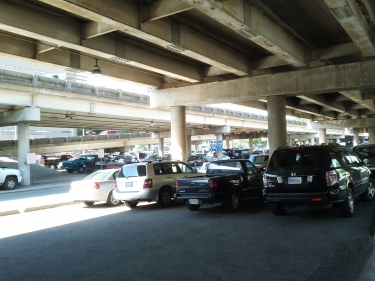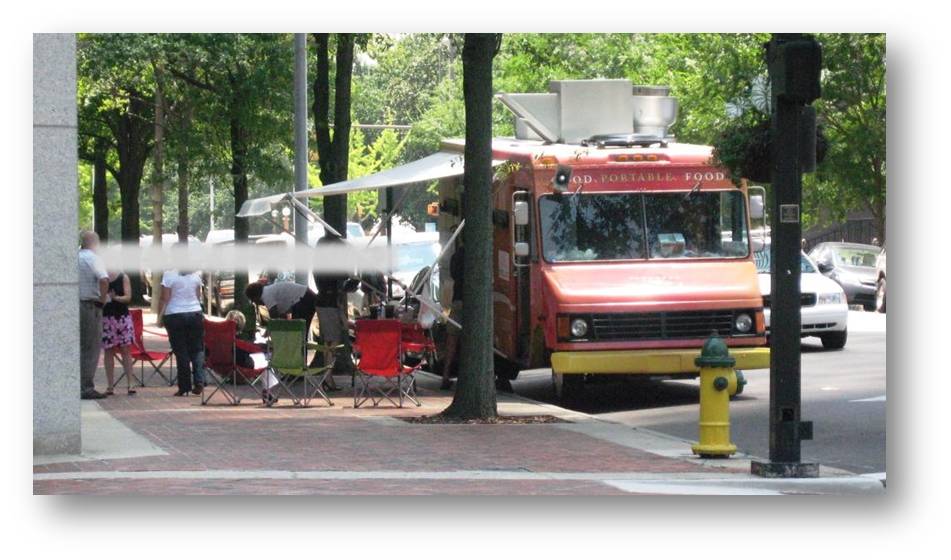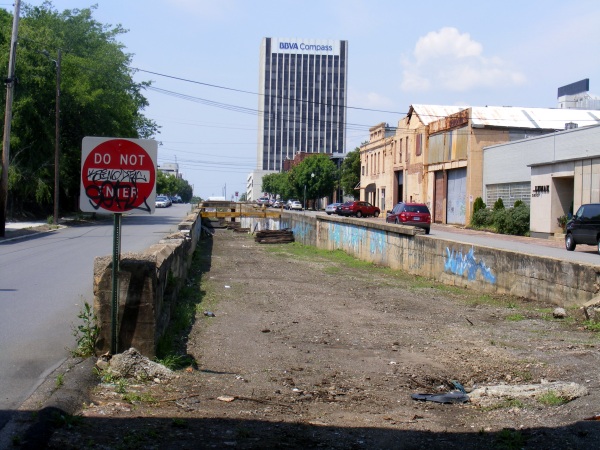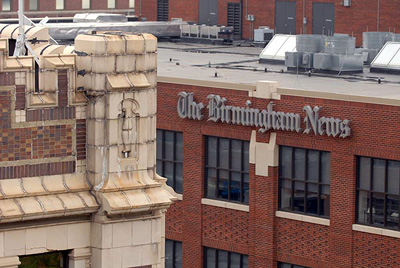EDITOR’S NOTE: There has been a great deal said recently about the food truck ordinance passed late last year and how it’s affecting outreach efforts in the City of Birmingham. Matt Lacey, the senior pastor of downtown’s Church of the Reconciler, has written this piece and shared it via social media and email. I felt it needed another, more openly accessible, place to reside. Links have been added by me where they seemed appropriate. As usual, comments are welcome and his contact information is below (though his email inbox was full as of this posting). ACN
One good way to make kind-hearted folks mad is to tell them it’s illegal for them to show that kindness.
Over the past couple of days here in Birmingham you may have heard reports in the media about the City of Birmingham threatening to arrest people for passing out food to the homeless in public parks and other gathering places.
The Mayor and City Council have said that they didn’t intent to create this type of environment by passing the food truck ordinance last year. Let me take some time to debunk that right away. This text is taken from page 9 of the aforementioned ordinance passed by the City Council:
“No person or business entity, including religious or charitable organization, shall operate a mobile food vehicle and/or pushcart upon the public rights-of-way within the city without a permit.”
Why would someone think to include religious and charitable organizations in the ordinance? More than likely they were attempting to bury legislation similar to other cities such as Raleigh, NC and others who have cracked down on public feedings in parks. In short: I think they knew what they were doing when they passed it.
To the issue of feeding at public parks: do churches, organizations, and volunteers need to have a conversation about the effectiveness of public feedings and the need for more permanent and ongoing help for the homeless? Absolutely. Is simply feeding at parks the best way to offer care for the homeless? Well, one could argue that you could do a lot more to offer more comprehensive care.
Organizations like ours-Church of the Reconciler-and the Firehouse Shelter, One Roof, and many others, frequently preach the need for more comprehensive services above and beyond just feeding the homeless. And there is certainly a lot to talk about. But is threatening to arrest people for feeding in public places a way to open up and have that conversation? Absolutely not.
Simply put: I’m not a public policy expert or a politician, but this isn’t going over well for the City of Birmingham. There are better ways to address this issue and have this conversation.
Mayor Bell, who in full disclosure was gracious enough to address one of our fundraising events several years ago, said that this is an effort to consolidate and organize services for the homeless through One Roof. That sounds really good, and One Roof does a great job of coordinating all these efforts currently.
Case in point: when police told Bridge Builders Ministries that they couldn’t serve the homeless outdoors any longer, we had a conversation with their leaders and opened our doors to create a more coordinated effort.
But if the Mayor and the City (and State of Alabama for that matter) are serious about this, it’s time they start providing more resources to care for those on the streets. Simply put: it’s time for Birmingham to stop talking and start doing.
I would like to issue an invitation to the Mayor and City Council members: come down to one of our organizations where, day after day, we offer care to those who need it most, rather than just bury something in an ordinance somewhere. Come and visit with those who suffer with mental illness and tell them, as we do, that there is little to no help we can offer because the State of Alabama lacks the resources (and will) to adequately address the issue. Come and argue, which I do on a weekly basis, with the drug dealers who prey on our population and help keep them in the cycle of addiction.
If we are going to talk about the need for more comprehensive help for the homeless, it’s probably best to not intimidate those attempting to do something about it, even those who might be well-intentioned but need to be more educated.
If the City wants to talk about the homeless in Birmingham, and ways they can help with the community my door is always open, as it has been.
Maybe this is the spark this City needs to starting talking about the issue of homelessness and poverty, which we have only treated with Band-Aids in the past, when in reality it needs comprehensive, holistic, and preventative care.
Rev. Matt Lacey
Senior Pastor, Church of the Reconciler
matt@churchofthereconciler.com
facebook.com/churchofthereconciler





 Yesterday I decided to point to a specific city that’s actually tackled an inner-city interstate replacement and
Yesterday I decided to point to a specific city that’s actually tackled an inner-city interstate replacement and  Yes, there’s recently been a significant amount of focus on proposed plans for I-20/59. Diehards have been aware of the topic since
Yes, there’s recently been a significant amount of focus on proposed plans for I-20/59. Diehards have been aware of the topic since  This year’s
This year’s  A drive along 1st Avenue South heading east contains a significant yet subtle development for those able to stop and take a look. You’ll notice the absence of rails and ties both in the area known as
A drive along 1st Avenue South heading east contains a significant yet subtle development for those able to stop and take a look. You’ll notice the absence of rails and ties both in the area known as  There’s been something nagging at me for a while now about
There’s been something nagging at me for a while now about 

Still dreaming big dreams for Birmingham in 2021
UPDATE: Birmingham was awarded the 2021 World Games on January 22, 2015.
I smirked as I said this during a chance encounter with David Brewer, executive director of the Friends of Rickwood Field, as we stood looking out at home plate in America’s oldest ballpark late Monday morning.
He laughed and said, “You know, you’re right,” as he returned to the never ending list of to-dos associated with his job, leaving me to think. I often find myself there in the historic structure on the city’s west side sitting in the general admission seats (or the first base dugout) in order to escape and think. This time, I tried to calm my mind to tackle some brainstorming but ended up dreaming big dreams. (It’s a bad habit of mine.) I thought of what it would be like to sit in the stands at Rickwood Field and Regions Field surrounded by others from around the world in 2021. It would take the International Baseball Federation successfully campaigning the International World Games Association to be added as a sport or a request of the city’s organizing committee, but there’s a chance…
That said, this current proposal is a little easier to swallow for folks and easier to celebrate if successful (especially since it would be during Birmingham’s 150th birthday, but I digress). While the World Games started as a way to focus more on the athletes and less on keeping score among nations, they have come to be as significant in meaning to the host city as a successful Olympic bid without nearly the same level of expense.
Why? Here it is, courtesy of the bid packet:
This means that while the multi-purpose facility (a.k.a. the Dome) is probably going to happen, it’s not affecting this bid one way or the other. That can be also read as it doesn’t necessarily mean facilities can’t be renovated or modernized in order to accommodate events. This suddenly makes things like seeing a City Council agenda item for a feasibility study of Legion Field earlier this year more understandable (especially when coupled with the mayor’s comments during this year’s State of the City address).
This is a city that needs an excuse to light a fire under itself to get something accomplished. It also needs reassurances from outsiders. This would seem to accomplish both while, as said elsewhere previously, leaving the city in a better place if the bid proves unsuccessful.
The DNC bid was due last Friday, June 6 (and some have already written about its potential for success, including this piece on June 9 by Cliff Sims at Yellowhammer News and this one published on June 8 by Chuck Dean of al.com/Alabama Media Group). The World Games bid is due on July 31. Once it’s arrived in Colorado, the hard part begins. We have to keep dreaming big dreams and acting on them.
After watching this recap video from the 2013 World Games in Cali, Colombia (or photos like this one from its closing ceremonies), I’m thinking it shouldn’t be too hard to do.
BTW – it should be noted that American football was chosen as one of the invitational sports for the 2017 World Games in Wroclaw, Poland. Just saying…
André Natta is the stationmaster for bhamterminal.com.
Leave a comment
Posted in Commentary, development
Tagged AL, bid, Birmingham, chances, opinion, World Games